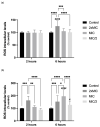Disclosing the Antifungal Mechanisms of the Cyclam Salt H4[H2(4-CF3PhCH2)2Cyclam]Cl4 against Candida albicans and Candida krusei
- PMID: 38791254
- PMCID: PMC11121207
- DOI: 10.3390/ijms25105209
Disclosing the Antifungal Mechanisms of the Cyclam Salt H4[H2(4-CF3PhCH2)2Cyclam]Cl4 against Candida albicans and Candida krusei
Abstract
Mycoses are one of the major causes of morbidity/mortality among immunocompromised individuals. Considering the importance of these infections, the World Health Organization (WHO) defined a priority list of fungi for health in 2022 that include Candida albicans as belonging to the critical priority group and Pichia kudriavzevii (Candida krusei) to the medium priority group. The existence of few available antifungal drugs, their high toxicity, the acquired fungal resistance, and the appearance of new species with a broader spectrum of resistance, points out the need for searching for new antifungals, preferably with new and multiple mechanisms of action. The cyclam salt H4[H2(4-CF3PhCH2)2Cyclam]Cl4 was previously tested against several fungi and revealed an interesting activity, with minimal inhibitory concentration (MIC) values of 8 µg/mL for C. krusei and of 128 µg/mL for C. albicans. The main objective of the present work was to deeply understand the mechanisms involved in its antifungal activity. The effects of the cyclam salt on yeast metabolic viability (resazurin reduction assay), yeast mitochondrial function (JC-1 probe), production of reactive oxygen species (DCFH-DA probe) and on intracellular ATP levels (luciferin/luciferase assay) were evaluated. H4[H2(4-CF3PhCH2)2Cyclam]Cl4 induced a significant decrease in the metabolic activity of both C. albicans and C. krusei, an increase in Reactive Oxygen Species (ROS) production, and an impaired mitochondrial function. The latter was observed by the depolarization of the mitochondrial membrane and decrease in ATP intracellular levels, mechanisms that seems to be involved in the antifungal activity of H4[H2(4-CF3PhCH2)2Cyclam]Cl4. The interference of the cyclam salt with human cells revealed a CC50 value against HEK-293 embryonic kidney cells of 1.1 μg/mL and a HC10 value against human red blood cells of 0.8 μg/mL.
Keywords: cyclam salt; mechanism of action; metabolic viability; mitochondrial function; yeasts.
Conflict of interest statement
The authors declare no conflicts of interest.
Figures





References
-
- Gold J.A.W., Ahmad F.B., Cisewski J.A., Rossen L.M., Montero A.J., Benedict K., Jackson B.R., Toda M. Increased Deaths From Fungal Infections During the Coronavirus Disease 2019 Pandemic-National Vital Statistics System, United States, January 2020–December 2021. Clin. Infect. Dis. 2023;76:e255–e262. doi: 10.1093/cid/ciac489. - DOI - PMC - PubMed
-
- World Health Organization (WHO) WHO Fungal Priority Pathogens List to Guide Research, Development and Public Health Action. WHO; Geneva, Switzerland: 2022.
-
- World Health Organization (WHO) United Nations Environment Programme and World Organisation for Animal Health: A Guide to Implementing the One Health Joint Plan of Action at National Level. WHO; Geneva, Switzerland: 2023.
-
- Fisher M.C., Alastruey-Izquierdo A., Berman J., Bicanic T., Bignell E.M., Bowyer P., Bromley M., Brüggemann R., Garber G., Cornely O.A., et al. Tackling the emerging threat of antifungal resistance to human health. Nat. Rev. Microbiol. 2022;20:557–571. doi: 10.1038/s41579-022-00720-1. - DOI - PMC - PubMed
MeSH terms
Substances
Supplementary concepts
Grants and funding
LinkOut - more resources
Full Text Sources
Miscellaneous

